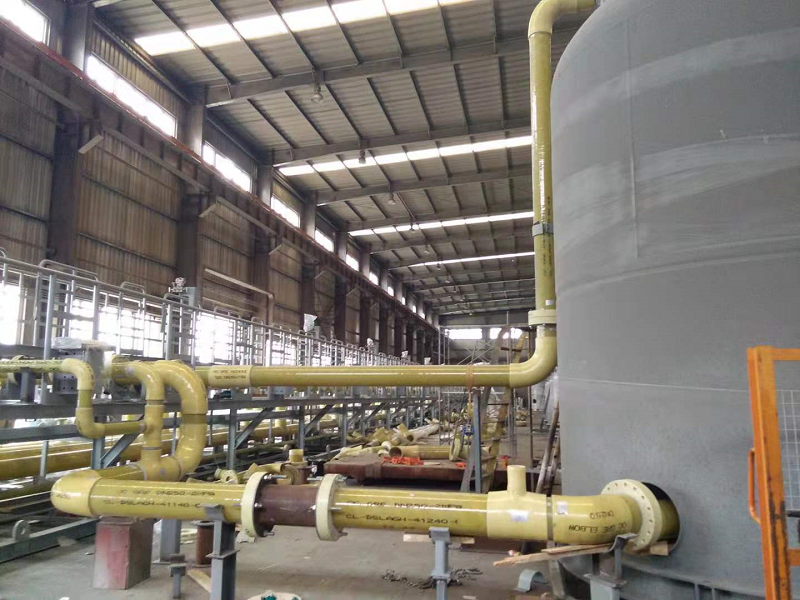
In the water treatment industry, the performance of the pipeline system is directly related to water quality safety, operating costs and engineering sustainability. Although traditional metal pipes (such as steel pipes and cast iron pipes) and plastic pipes (such as PVC and HDPE) are widely used, their corrosion resistance, short lifespan & high maintenance costs have gradually become pain points in the industry. Glass fiber reinforced epoxy (GRE) pipes are becoming a new preferred material in the water treatment field due to their unique material properties.
Excellent corrosion resistance: breaking through industry bottlenecks
In the water treatment environment, the pipeline is in contact with corrosive media (such as chloride ions, acid and alkali solutions, high-salt wastewater, etc.) for a long time, and metal pipelines are prone to electrochemical corrosion, leading to leakage, water pollution and other problems. GRE pipes are based on epoxy resin and reinforced with glass fiber. They are extremely chemically inert and can resist the erosion of most acids, alkalis, salts and organic solvents. For example, in seawater desalination projects, GRE pipelines can withstand long-term erosion of high-salinity seawater; in sewage treatment plants, their performance against corrosive gases such as hydrogen sulfide and sulfate far exceeds that of metal pipelines. In addition, GRE pipelines do not need cathodic protection or anti-corrosion coating like metal pipelines, and their design life can reach more than 30 years, significantly reducing the replacement frequency and emergency maintenance costs caused by corrosion.
Light weight & high strength: engineering efficiency & performance
Traditional metal pipes are heavy & require high costs for transportation, installation & supporting structures. The density of GRE pipes is only 1/4 of that of steel, but it can provide mechanical strength close to that of steel.
Easy installation: Its lightweight feature makes it suitable for long-distance water delivery, construction in mountainous areas or complex underground environments, and the hoisting efficiency is increased by more than 50%
Fatigue & impact resistance: The toughness of glass fiber gives the pipe good dynamic load bearing capacity
Wide adaptability: The operating temperature covers -40℃ to 93℃ & can be used in scenarios such as chilled water transportation & hot water circulation systems.
Optimizing hydraulic performance: the key to saving energy & reducing consumption
In the water treatment system, the roughness of the inner wall of the pipe directly affects the water delivery efficiency. The inner surface of the GRE pipe is smooth (Hazen-Williams coefficient ≥ 150), and the friction resistance is much lower than that of metal pipes (such as cast iron pipe coefficient of about 100), which can reduce the head loss by 15%-30%. Taking the municipal pipe network with a daily water delivery of 100,000 tons as an example, the use of GRE pipes can save hundreds of thousands of kilowatt-hours of electricity each year.
At the same time, the smooth inner wall can effectively inhibit scale deposition and microbial attachment. This feature is particularly important in drinking water transportation, which can not only reduce the frequency of chemical cleaning, but also avoid secondary pollution problems such as "red water" and "yellow water", ensuring the safety of terminal water quality.
Cost advantage throughout the life cycle: significant long-term benefits
Although the initial purchase cost of GRE pipes is slightly higher than some traditional materials, its low maintenance and long life characteristics can significantly reduce the overall cost:
Maintenance-free design: no need for anti-corrosion treatment or coating repair, saving labor and material costs.
Durability: within a 30-year service life, the total cost is 40%-60% lower than that of metal pipes.
Quick construction: flexible connection methods such as flanges, sockets or adhesive connections are used, which shortens the construction period by more than 30%, especially suitable for emergency repairs or expansion projects.
GRE pipes provide the water treatment industry with an integrated solution that is corrosion-resistant, lightweight, long-life, and low-energy through the combination of material science and engineering design. As environmental regulations become stricter and the demand for infrastructure upgrades increases, GRE pipes will become the core choice for future water treatment system upgrades with their technical and economic advantages, helping the industry move towards an efficient and sustainable direction.
Please give us a message
产品介绍产品介绍产品介绍产品介绍产品介绍产品介绍产品介绍产品介绍产品介绍产品介绍产品介绍产品介绍产品介绍产品介绍产品介绍产品介绍产品介绍产品介绍产品介绍产品介绍产品介绍产品介绍产品介绍产品介绍产品介绍产品介绍产品介绍产品介绍产品介绍产品介绍
Please give us a message
产品介绍产品介绍产品介绍产品介绍产品介绍产品介绍产品介绍产品介绍产品介绍产品介绍产品介绍产品介绍产品介绍产品介绍产品介绍产品介绍产品介绍产品介绍产品介绍产品介绍产品介绍产品介绍产品介绍产品介绍产品介绍产品介绍产品介绍产品介绍产品介绍产品介绍
Please give us a message
产品介绍产品介绍产品介绍产品介绍产品介绍产品介绍产品介绍产品介绍产品介绍产品介绍产品介绍产品介绍产品介绍产品介绍产品介绍产品介绍产品介绍产品介绍产品介绍产品介绍产品介绍产品介绍产品介绍产品介绍产品介绍产品介绍产品介绍产品介绍产品介绍产品介绍
Please give us a message
产品介绍产品介绍产品介绍产品介绍产品介绍产品介绍产品介绍产品介绍产品介绍产品介绍产品介绍产品介绍产品介绍产品介绍产品介绍产品介绍产品介绍产品介绍产品介绍产品介绍产品介绍产品介绍产品介绍产品介绍产品介绍产品介绍产品介绍产品介绍产品介绍产品介绍
